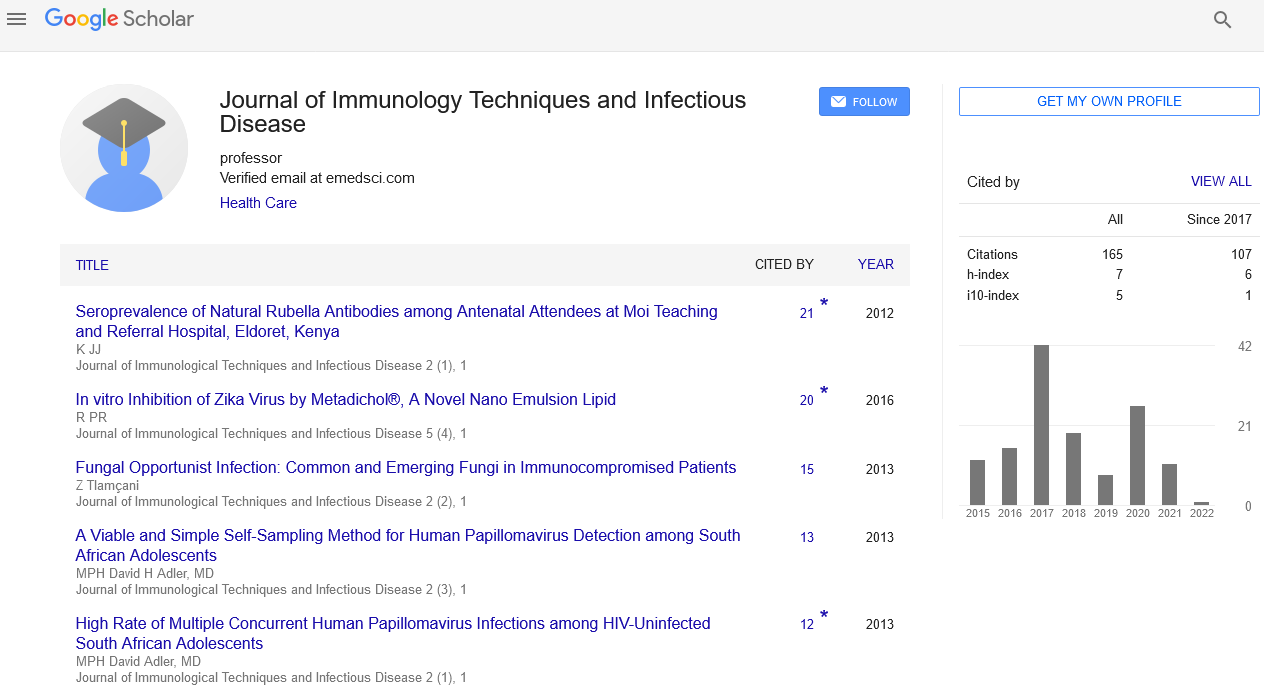Perspective, J Immunol Tech Infect Dis Vol: 13 Issue: 3
The Impact of Infectious Diseases: Morbidity, Mortality, and Global Health Solutions
Moses Caid*
1Department of Pediatrics, University of Arkansas for Medical Sciences, Little Rock, United States of America
*Corresponding Author: Moses Caid,
Department of Pediatrics, University of
Arkansas for Medical Sciences, Little Rock, United States of America
E-mail: caidmoses@unc.edu
Received date: 26 August, 2024, Manuscript No. JIDIT-24-151947;
Editor assigned date: 28 August, 2024, PreQC No. JIDIT-24-151947 (PQ);
Reviewed date: 11 September, 2024, QC No. JIDIT-24-151947;
Revised date: 18 September, 2024, Manuscript No. JIDIT-24-151947 (R);
Published date: 25 September, 2024, DOI: 10.4172/2329-9541.1000388
Citation: Caid M (2024) The Impact of Infectious Diseases: Morbidity, Mortality and Global Health Solutions. J Immunol Tech Infect Dis 13:3.
Description
Infectious diseases are caused by pathogens such as bacteria, viruses, fungi and parasites. They have been a major cause of morbidity and mortality throughout human history and despite modern medical advancements, continue to provide significant health challenges around the world. From pandemics include COVID-19 to endemic diseases such as malaria, infectious diseases affect people across every region, age and socioeconomic group.
Infectious diseases result from the invasion of the body by pathogens that disrupt normal body functions. The severity of these diseases can vary widely, ranging from mild infections, such as the common cold, to life-threatening conditions including Ebola and HIV/ AIDS. Infectious diseases are frequently categorized based on the type of pathogen responsible and how they are transmitted.
The global impact of infectious diseases
Infectious diseases have a great impact on global health, affecting mortality rates, quality of life and economic productivity. Historically, epidemics and pandemics have shaped societies by causing widespread mortality and social disruption. In modern times, infectious diseases continue to challenge healthcare systems, particularly in Low-and Middle-Income Countries (LMICs).
Morbidity and mortality: Infectious diseases remain a leading cause of death around the world, especially among young children, the elderly and infected persons. Diseases including HIV/AIDS, tuberculosis and malaria have claimed millions of lives, particularly in regions with limited access to healthcare and preventive measures.
Economic and social impact: Infectious diseases can disrupt economies by reducing productivity and straining healthcare systems. Epidemics and pandemics, such as Ebola and COVID-19, have highlighted the significant economic costs of managing widespread outbreaks, from healthcare expenditures to lost labor and disrupted supply chains. Additionally, disease outbreaks frequently lead to social stigma, discrimination and mental health challenges among affected populations.
Disparities in health outcomes: Infectious diseases disproportionately affect vulnerable populations, including those in LMICs, due to factors such as poverty, poor sanitation and limited access to healthcare and limited environments for living. For example, while malaria is completely reduced in advanced nations, it remains a significant health burden in sub-Saharan Africa, where lack of resources and prevention measures continue to facilitate transmission.
Common infectious diseases and their prevention Efforts to prevent infectious diseases focus on reducing transmission, improving healthcare access and increasing hygiene and vaccination. Some of the most common infectious diseases worldwide include.
Malaria: Caused by Plasmodium parasites transmitted through mosquito bites, malaria remains a major public health issue in tropical regions. Preventive measures include the use of insecticide-treated bed nets, antimalarial drugs and indoor insecticide spraying. New vaccine developments, such as the RTS, S malaria vaccine, have also demonstrated potential for reducing incidents in regions with endemic disease.
HIV/AIDS: HIV/AIDS is caused by the Human Immunodeficiency Virus (HIV), which damages the immune system and can lead to Acquired Immunodeficiency Syndrome (AIDS). Prevention strategies include needle-exchange programs and the use of Pre-Exposure Prophylaxis (PrEP). Antiretroviral Therapy (ART) has transformed HIV from a fatal disease to a manageable chronic condition, significantly reducing HIV-related deaths and transmission.
Infectious diseases continue to impact individuals and societies around the world. Understanding the types of infectious diseases, their transmission and their effects on health is essential for managing and preventing outbreaks. With on-going research, advancements in vaccine technology and global health initiatives, it is possible to reduce the burden of infectious diseases and increase healthier populations. However, challenges such as AMR, vaccine anxiety and inequitable healthcare access remain. Addressing these issues requires an organized effort from governments, healthcare providers and communities to ensure effective prevention, management and control of infectious diseases.
 Spanish
Spanish  Chinese
Chinese  Russian
Russian  German
German  French
French  Japanese
Japanese  Portuguese
Portuguese  Hindi
Hindi 
